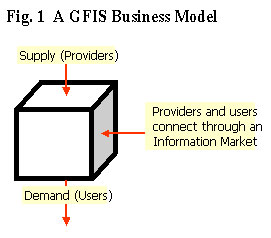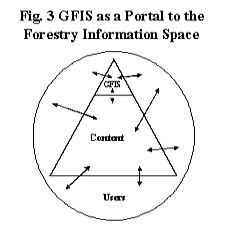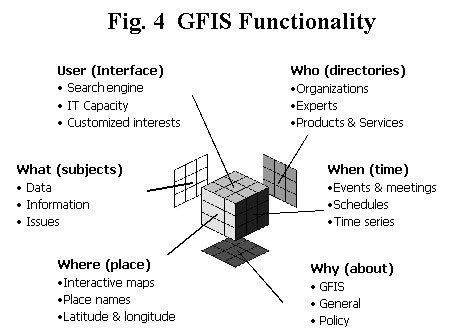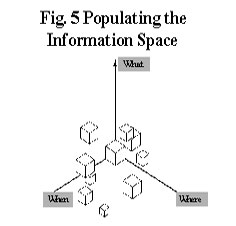

0006-A4
Albert J. Simard 1
This paper proposes establishing an operational Global Forest Information Service (GFIS). It reviews issues associated with transforming GFIS concepts into operational reality. It begins by describing the global drivers for the proposed service as well as the global market for forestry information. It then outlines a number of opportunities and challenges associated with establishing GFIS, along with a risk management strategy. This is followed by a review of the mission and goals that GFIS would pursue as well as it's role in the forestry information market. The document concludes by proposing an implementation strategy for GFIS.
The "Knowledge Revolution" is changing the way we live, how we work and do business, how we educate our children, study and do research, train ourselves, and how we are entertained (G7 Information Society, 1995). The Key attributes of the "information society" include: an accelerating rate of change, increasingly complex technology, networks as a key organizational structure, an overabundance of information, global-scale connectivity, and increasingly complex issues. These changes are expected to reshape the world on a scale equal to the agricultural and industrial revolutions. These changes will also reshape forestry and forest science in very profound ways.
In the knowledge-based economy, adding value will be less dependant on processing atoms and more dependant on processing bits. The ability to create and use new knowledge is seen as the only sustainable competitive advantage. Although this would seem to put forestry research organizations in an ideal position, creating knowledge is not enough. Knowledge must be managed as an asset to be accessible, it must be shared before it can be used; and it must be used to complete the value chain (Simard, 2000). Creating and managing knowledge are primarily within the purview of forestry research organizations. The focus of GFIS, would be on sharing knowledge to facilitate its use, thereby leveraging its value.
Päivinen (2000) summarized a number of international forestry fora that have identified the need for a global-scale forest information system during the past decade. The UN conference on Environment and Development (1992) stated: "Existing national and international mechanisms of information processing and exchange...should be strengthened to insure effective and equitable availability of information." The World Forest Monitoring Workshop (1996) concluded: "an Internet-based information system is needed, which would be simple, decentralized and adaptable to changing information needs." The Intergovernmental Panel on Forests (1997) stated: "Attention should be given to world-wide access to information systems that would encourage...development and transfer of appropriate technologies and improved co-operation." The International Union of Forest Research Organizations (1998) established a Task Force "to develop a strategy for, and implement, an Internet-based metadata system that will provide coordinated worldwide access to forest information." Finally, the Intergovernmental Forum on Forests (2000) urged: "international organizations, doner countries and financial institutions to enhance access to forest-related information."
For more than a century, IUFRO has promoted global-scale "networking" among forestry research organizations and scientists. Within the emerging Information Society, IUFRO represents a global community of interest. Thus, from a cultural perspective, IUFRO is ideally suited to thriving in cyberspace.
The confluence of information and computer technologies makes it possible for IUFRO to fulfill its' traditional mission, but at the speed of light and to much greater effect. Conversely, IUFRO's traditional approaches - scientific fora and publications are no longer adequate. The world is moving faster, issues are more complex, and collaboration has become essential. Avoiding irrelevance in the 21 st century will require that organizations transform themselves as well as their products and services to a digital environment.

Forestry information spans a broad spectrum of subjects, perspectives, and applications as well as many spatial, temporal, and process scales. Meeting these diverse needs will be challenging. One way to describe the global exchange of forestry information is with a business model involving a marketplace comprising three sectors: providers, users, and information brokers (Fig. 1) The purpose of the market is to enable, support, and facilitate the exchange of forestry data, information, and knowledge among providers and users. Market is used here in the sense of information transactions irrespective of the exchange of money.

A. Providers create and disseminate information. The amount and nature of the available information is controlled by a broad range of provider mandates, roles, and capacities. They may provide repository services or links to repositories, facilitate search and retrieval, convert media and format to that needed by users, and disseminate information - at no cost, at market value, or something in between. Providers can be grouped into four organizational categories with broadly differing mandates, processes, and societal roles: academia, public sector, private sector, and non-governmental organizations (Fig. 2)
Every forestry-related organization in the world distributes and/or provides some access to it's information holdings. Dissemination ranges from traditional distribution of published documents via mail to digital access of electronic documents. It also ranges from disseminating only official reports to allowing interactive access to databases. Despite a willingness on the part of providers to make their information available, there are a number of barriers to sharing information, including: resources, technological capacity, knowledge, management, and institutional issues.
B. Users acquire information and apply it to addressing issues or solving problems. However, they often have difficulty in finding what they need, filtering relevant content, and applying it to their situation. In a digital environment, a browser and search engine are used to find and download information. User communities can be classified into four groups, based on the nature of their information needs: practitioners, general public, policy makers, and business (Fig. 2). Although information can yield high valued to users, its' relatively abundance and often limited ability to pay, results in a price of information that may be less than its cost.
Users are faced with a cacophony of providers and information. The primary challenge is to discover who has what information related to their needs. Then there is the issue of terminology, complicated by an international context. If the user chooses a different key word than an author, a match to relevant material cannot be found. There are several barriers to acquiring and using forestry information, including: technological capacity, searching, limited accessibility, language, retrieval, cost, and quality assurance.
C. Information Brokers, such as the IUFRO Information Sciences Division (6.03), act as intermediaries between providers and users. They add value by facilitating information transactions. They may provide repository services, publishing and reformatting services, search and retrieval services, manage financial transactions, and interpretive services. GFIS would essentially play an information broker role in the forestry information market.
Libraries have performed an information broker function for more than two millennia. They provide repositories for published knowledge, along with classification systems and thesauri to organize and index knowledge. They provide physical access to knowledge holdings. The CAB International adds value by abstracting published knowledge and disseminating syntheses to global subscribers. Information brokers also face barriers to facilitating information exchanges, including: resources to support international initiatives, multiple standards and types of information, legal issues, different languages and terminology, and costs of processing and managing information transactions.
Providers focus on organizational mandates; users on individual needs. There is a clear need for an information broker service to facilitate the exchange of information among providers and users. Because the bulk of the added value accrues to users, it is critical that resource requirements and effort be minimized for providers.
Global connectivity provides many opportunities for IUFRO to accomplish it's goals more efficiently and effectively than ever before as well as to positively affect the global forest agenda in ways that could only be imagined until recently. This section discusses the benefits of GFIS accruing to providers, users and global forestry, positive factors that will enhance the chances of success, and core strengths that have been and will be brought to bear to address the challenge.
A. Benefits
Developing and implementing a Global Forest Information Service would yield a number of benefits to IUFRO, providers, users, and the global forestry community.
IUFRO
Providers
Users
Forestry
B. Success Factors
A number of factors enhance the likelihood that GFIS would be successful.
C. Core Strengths
IUFRO brings substantial core strengths to support the development of GFIS.
Developing and implementing a Global Forest Information Service is an ambitious and complex undertaking. Many obstacles will have to be overcome if it is to succeed. Yet, with sufficient commitment by a critical mass of stakeholders, these obstacles can be resolved.
A. Obstacles
B. Risk management
This section begins with a statement of purpose and the mission. This is followed by a description of the role and scope of GFIS in the global forestry information market. The section ends with a brief description of the services and functionality that GFIS would provide.
GFIS would contribute towards enhanced sustainable development of the world's forests, the well-being of forest-reliant communities, informed public engagement in forest policy development, improved forest-related decision-making, the wise stewardship of global forest ecosystems, and understanding of complex forestry issues by facilitating the exchange of forestry data, information, and knowledge among providers and users around the world.
Enhance access to and provide high-quality forest-related information, especially that available through electronic media.

GFIS would act as an information broker to facilitate information exchanges among providers and users. Anyone with a computer connected to the Internet can currently access and retrieve information from anyone else who is also connected. The role of GFIS would be to add sufficient value to currently available information such that GFIS becomes the portal of choice for a critical mass of providers and users (Fig. 3).
Portals are gateways to an information space defined by a domain, such as forestry. Portals access content from a group of providers and may provide a some content and synthesis. Portals add value by providing search capability across multiple sites, organizing information, promoting standards, security, content management, tools for processing content, and quality control.
GFIS would provide a number of information services for the global forestry community.
An external view of the global forestry information space can be visualized as a cube, with each face representing one view / window / perspective into the space (Fig.4). In reality, a virtual information space can have any number of views, but the image of a cube facilitates communication as it is readily understandable by everyone. When someone "enters" the space through GFIS, they may do so through any "window." Although the six views could be organized around GFIS services, these are not the way that users are likely to search for content, nor is it easy to understand the types of content that are to be found underneath.

A better approach would be to structure the external windows around ways in which users are likely to look for content. The familiar "five Ws" (Who, What, When, Where, and Why) are useful in this respect. They are not only easy to remember, but also they relate to fundamentally different ways of organizing information. Adding a user interface for the sixth face completes the external view of how GFIS content would appear to users (Fig. 4).
Internally, GFIS content would be structured very differently. Each element would be stored only once with attached metadata relating to each external view. Three views or dimensions of content (time, space, and subject) are shown in Fig. 5. A user might be interested in a subject, when an event occurred, or the place to which it applies. Conversely, this is also a "no wrong

door" approach in that no matter how a user enters the information space, they find the information that they are looking for. Figure 5 also shows that it is not necessary (as well as infeasible) to populate the entire information space to achieve functionality. Rather, only existing information that is readily accessible need be included. Finally, most information would be relevant to only a subset of external views. For example, the strength of wood for construction has no space or time attribute.
GFIS would be organized as a non-profit IUFRO program. It would be important that GFIS is on a firm institutional footing to ensure prototype development and service delivery. A voluntary structure may be insufficient. Rather than create an international agreement in law, however, signed agreements and contracts probably would be appropriate and sufficient.
GFIS would be financed through one or more approaches, ranging from grants from one or more sponsoring institutions, through IUFRO levies and investment, to leveraging, cost recovery, and a connection fee. The proposed budget for developing a prototype GFIS is $750k per year for 3 years (Table 1). Much of the total may be obtainable through in-kind contributions from IUFRO members. The annual budget may be reduced by stretching out the program or reducing the scope of GFIS.
| Table 1. Proposed annual budget - Prototype Phase |
| Staff - (5 people) + overhead | $365k |
| Capital (software, hardware) | $135k |
| Operations (administration, travel) | $140k |
| Support (working groups, projects) | $110k |
| Total | $754k |
Governance is essential to any collective activity in an organization. It addresses the simple but crucial question - who is responsible for what? This is divided into categories such as mandate, hierarchy of authority and accountability, and roles and responsibilities of participants. A three-tiered, four-component governance structure is envisioned.
Participation in GFIS may be extended beyond forest research organizations to any group that can support or assist in developing and implementing GFIS. Three categories of membership are envisioned:
There are existing initiatives that provide global-scale data and information on forests and forestry. GFIS would link to these initiatives, avoid redundancy or duplicating their efforts, coordinate its activities with theirs, mutually leverage activities to the extent possible, and increase global connectivity. In some cases, formal partnership agreements would be negotiated (i.e., the Center for International Forestry Research and the Food and Agricultural Organization).
GFIS would coordinate its activities with global and regional-scale initiatives, such as CAB International, Global Biodiversity Information Facility, Global Observation of Forest Cover, IUFRO Division 6.03 - Information Sciences, International Tropical Timber Organization, Montreal Process (and others), and Temperate and Boreal Forest Resources Assessment.
G7 Information Society. 1995. Proc: Information Society Conference, Brussels, Belgium. 25-26 Feb.1995 G7 Secretariat.
Päivinen, R., E. Landis, R. Mills, G. Petrokofsky, D. Langor, and A. Schuck. 2000. Global Forest Information Service. Proc: World Forestry Congress, Kuala Lumpur, 7-12 Aug. 2000.
Simard, Albert. 2000. Managing Knowledge at the Canadian Forest Service. Natural Resources Canada, Canadian Forest Service, Ottawa, Ontario. 88p.
1 Director, Knowledge Management Division, Canadian Forest Service, 580 Booth Street, Ottawa, Ontario K1A 0E4 Canada, 613-947-9090, [email protected]